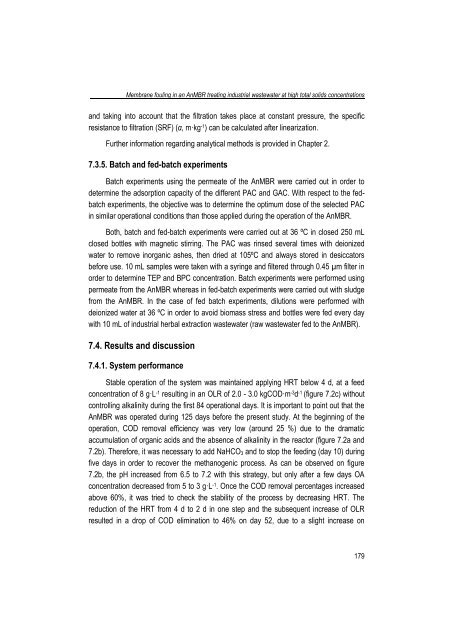Combining submerged membrane technology with anaerobic and ...
Combining submerged membrane technology with anaerobic and ...
Combining submerged membrane technology with anaerobic and ...
Create successful ePaper yourself
Turn your PDF publications into a flip-book with our unique Google optimized e-Paper software.
Membrane fouling in an AnMBR treating industrial wastewater at high total solids concentrations<strong>and</strong> taking into account that the filtration takes place at constant pressure, the specificresistance to filtration (SRF) (α, m·kg -1 ) can be calculated after linearization.Further information regarding analytical methods is provided in Chapter 2.7.3.5. Batch <strong>and</strong> fed-batch experimentsBatch experiments using the permeate of the AnMBR were carried out in order todetermine the adsorption capacity of the different PAC <strong>and</strong> GAC. With respect to the fedbatchexperiments, the objective was to determine the optimum dose of the selected PACin similar operational conditions than those applied during the operation of the AnMBR.Both, batch <strong>and</strong> fed-batch experiments were carried out at 36 ºC in closed 250 mLclosed bottles <strong>with</strong> magnetic stirring. The PAC was rinsed several times <strong>with</strong> deionizedwater to remove inorganic ashes, then dried at 105ºC <strong>and</strong> always stored in desiccatorsbefore use. 10 mL samples were taken <strong>with</strong> a syringe <strong>and</strong> filtered through 0.45 µm filter inorder to determine TEP <strong>and</strong> BPC concentration. Batch experiments were performed usingpermeate from the AnMBR whereas in fed-batch experiments were carried out <strong>with</strong> sludgefrom the AnMBR. In the case of fed batch experiments, dilutions were performed <strong>with</strong>deionized water at 36 ºC in order to avoid biomass stress <strong>and</strong> bottles were fed every day<strong>with</strong> 10 mL of industrial herbal extraction wastewater (raw wastewater fed to the AnMBR).7.4. Results <strong>and</strong> discussion7.4.1. System performanceStable operation of the system was maintained applying HRT below 4 d, at a feedconcentration of 8 g·L -1 resulting in an OLR of 2.0 - 3.0 kgCOD·m -3 d -1 (figure 7.2c) <strong>with</strong>outcontrolling alkalinity during the first 84 operational days. It is important to point out that theAnMBR was operated during 125 days before the present study. At the beginning of theoperation, COD removal efficiency was very low (around 25 %) due to the dramaticaccumulation of organic acids <strong>and</strong> the absence of alkalinity in the reactor (figure 7.2a <strong>and</strong>7.2b). Therefore, it was necessary to add NaHCO 3 <strong>and</strong> to stop the feeding (day 10) duringfive days in order to recover the methanogenic process. As can be observed on figure7.2b, the pH increased from 6.5 to 7.2 <strong>with</strong> this strategy, but only after a few days OAconcentration decreased from 5 to 3 g·L -1 . Once the COD removal percentages increasedabove 60%, it was tried to check the stability of the process by decreasing HRT. Thereduction of the HRT from 4 d to 2 d in one step <strong>and</strong> the subsequent increase of OLRresulted in a drop of COD elimination to 46% on day 52, due to a slight increase on179
















